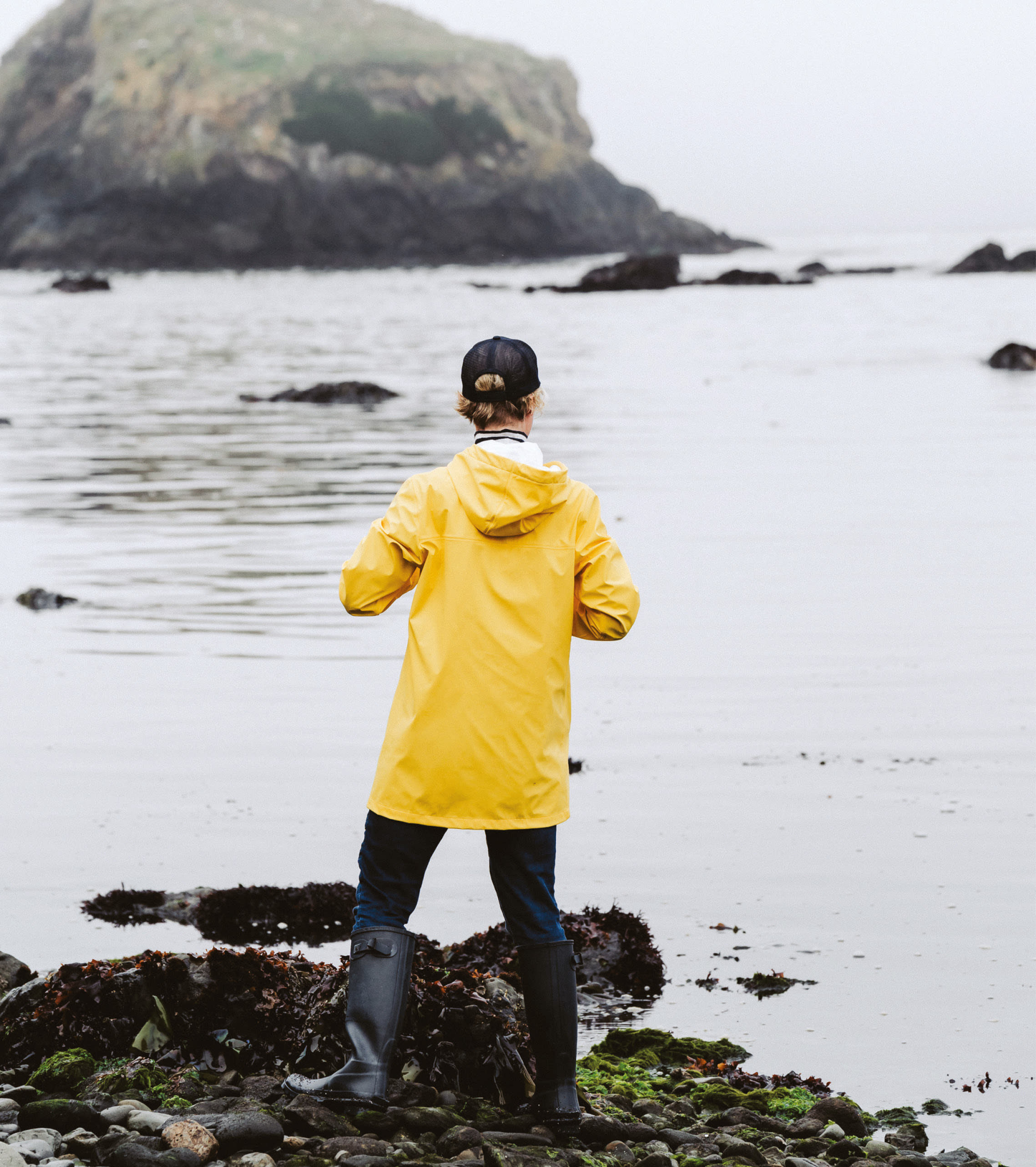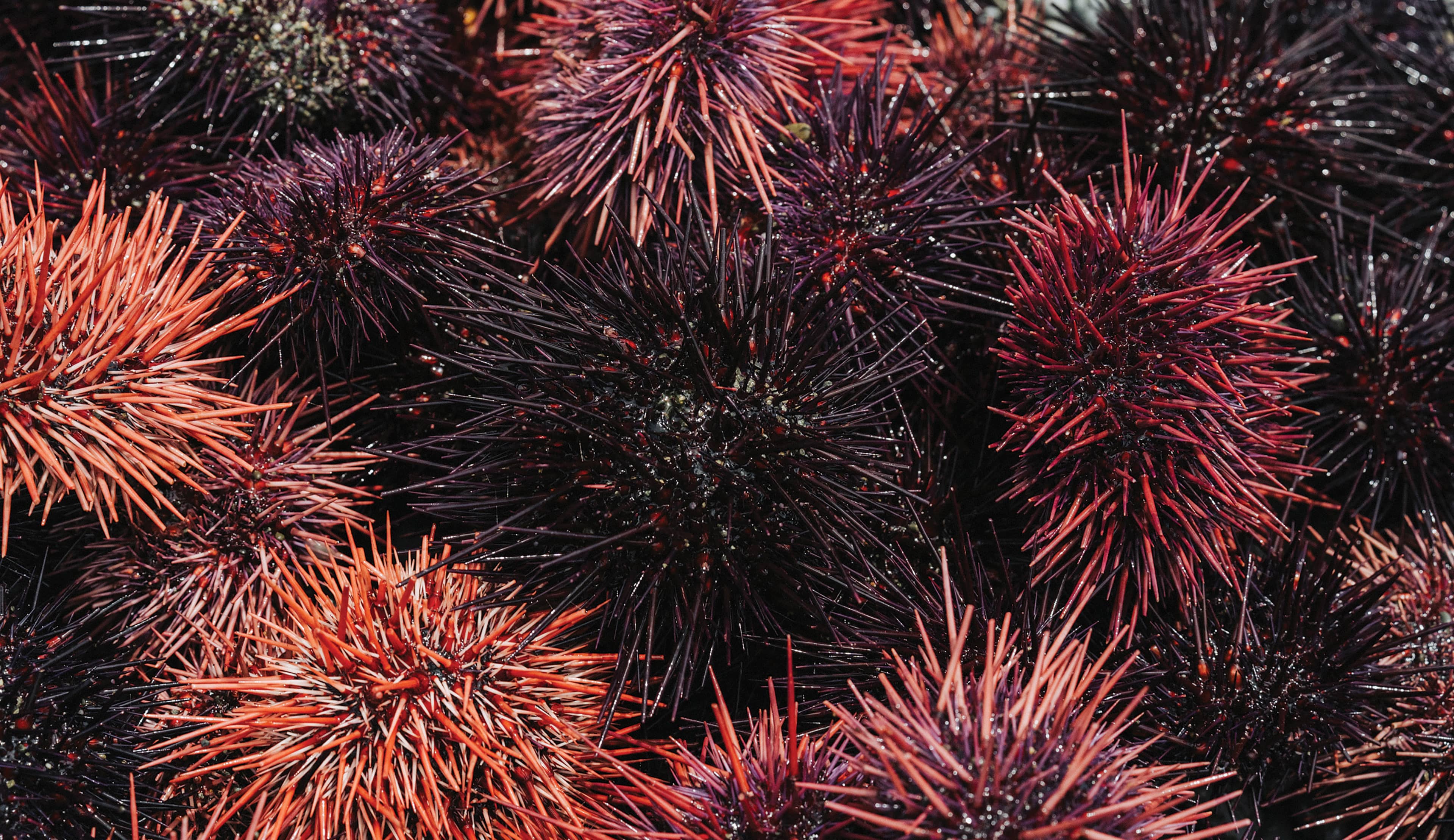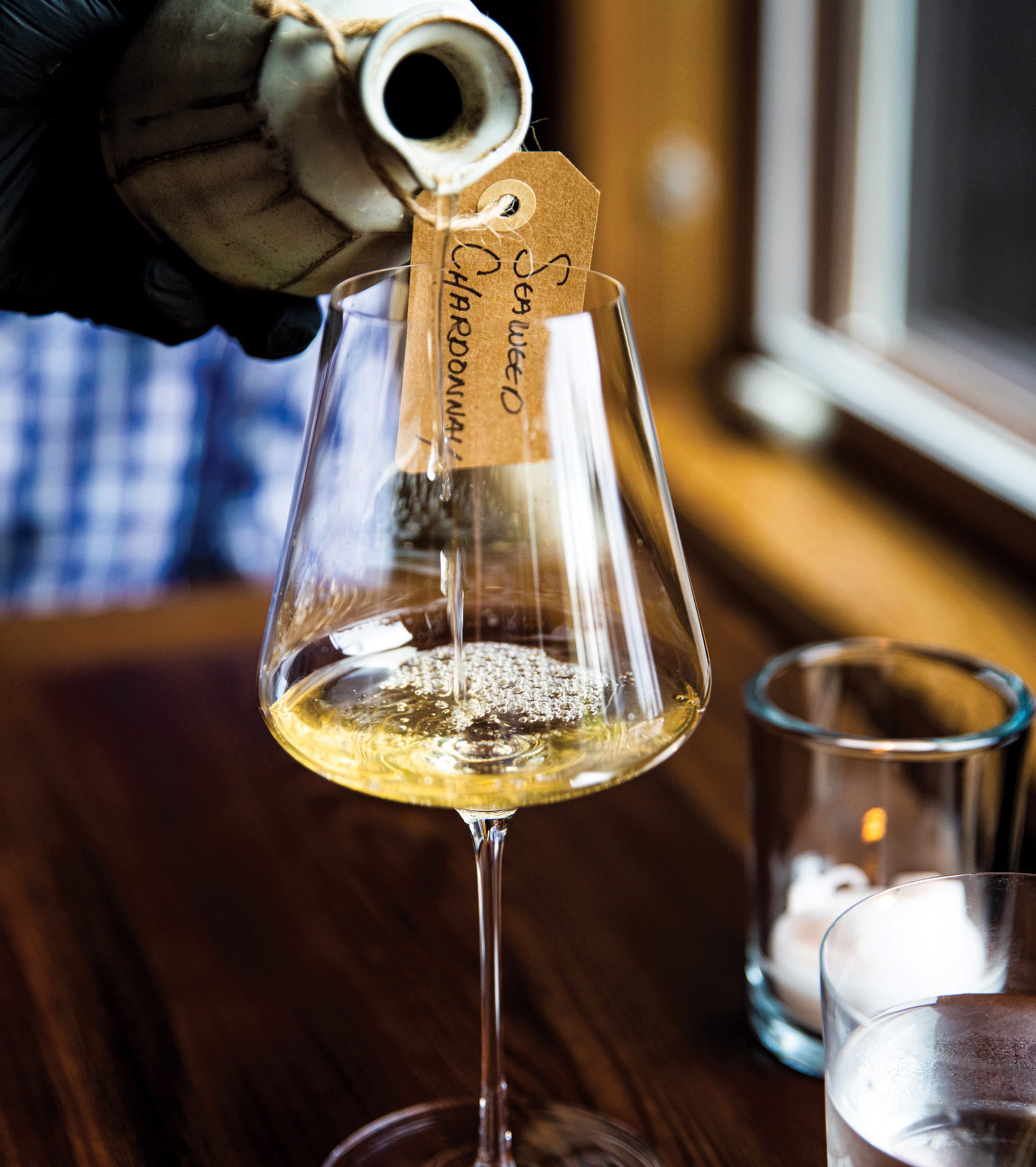F8
Travel
Volume 2
Coastal Culture
The next frontier in hospitality won’t just be more of the same old luxury — it’s all about sustainability now, and forevermore. Meet some of the champions committed to doing good for the planet, for travelers and for the bottom line.
Words by Jennifer Leigh Parker
Photos courtesy Visit Mendocino, Mandarin Oriental Hotel Group
It’s not quite 5:30 in the morning, but the crowd on Van Damme State Beach has already gathered in the mid-June fog, slurping thermos coffee out of paper cups and clipping waist belts onto their chest-high waders. They’re “gearing up” for the shivering-cold tide pools off the Mendocino coast, to hunt for purple sea urchins.
“Forget everything you know about walking upright — you will slip on this seaweed like a banana peel, I kid you not!” shouts Kevin Smith, Ph.D., a local maritime archaeologist and foraging guide for hire. He’s commanding a motley crew of 30-odd amateur adventurers to get down on all fours and crab-crawl over the exposed reef in search of the enemy. Armed with dull butter knives, we make our way to the pools, proudly prying the spiny sea urchins off the rocks and into our buckets, one at a time.
There is no chase in this hunt. Millions of purple sea urchins blanket the rocks and creep along the ocean floor from Baja California all the way up to British Columbia. Our morning catch, a few hundred between us, isn’t even a drop in the bucket…because we’re too late.
A marine warming event referred to as “The Blob” was first detected in 2013 in the Gulf of Alaska. It killed the local sea star population, one of the main predators of purple urchins.
“They were beautiful; I mean huge sea stars. When they died off, you started to see this spread of purple, and the overgrazing of kelp forests — which completely wrecked the ecosystem,” says Smith, cracking open a spiny urchin shell with a spoon, shaking off the excess liquid and scooping out tender orange strips of edible uni.
More than 95% of the area’s kelp forests have since been decimated, according to the state’s Ocean Protection Council. “People don’t know that. And it’s right outside our door.”
Smith is just one of the many proselytizers you’ll find in this county, which has coalesced around the “save the kelp” banner — for good cause. Apart from creating a home that sustains a wide variety of sea life, kelp forests store a staggering amount of carbon — approximately 20 times more per acre than forests on land.
For the local hospitality industry, it’s also a money issue. Seaweed forests pumped more than $250 million into the state’s economy each year by way of commercial fishing and recreational diving, according to the Nature Conservancy, a global environmental nonprofit.
Roughly $55 million of that was due solely to a large, sweet and tender marine mollusk called abalone, once the star of its own cottage industry. Locals say it tastes better than lobster. But without kelp, wild abalone starve — which prompted the closure of California’s recreational abalone fishery in 2017, along with a statewide moratorium enacted by the California Department of Fish and Wildlife. (A few licensed farms are what’s left of the state’s abalone supply.)
Before 2017, some 35,000 divers visited Mendocino and Sonoma counties each spring to collect abalone. They haven’t returned. That’s a significant loss in a place where tourism is the main industry.


Local ceramist Leila Al-Hemali sells handmade coffee mugs and saucers glazed with urchin powder to Mendocino beachgoers. | alhemalistudios.com
Welcome to Urchin Fest
For this reason, the Visit Mendocino tourism board, together with the MendoParks association and its born-and-bred ringleader, Cally Dym, proprietor of the Little River Inn, now hosts an annual three-day Urchin Fest to increase tourism and provide a hands-on educational experience for travelers.
Participants are treated to an urchin tide pool excursion, a catch-and-prepare demo and educational talks on the beach, led by the Nature Conservancy and the Noyo Center for Marine Science. The event culminates in a Saturday evening dinner at the Little River Inn, this year helmed by chef Marc Dym and sushi chef Frank Takao, who can sling shots of uni like a Vegas croupier with one hand and assemble fresh tuna rolls with the other.
Surrounding hotels and restaurants — including the MacCallum House; the Inn at Schoolhouse Creek; SCP Mendocino Inn and Farm; the Elk Cove Inn, Restaurant and Spa; and the Inn at Newport Ranch — also get in on the action by offering weekend package discounts, inviting guests to join the festival or by serving uni on their menus.
One weekend won’t change the nature of things in Mendo, as locals call it, but the camaraderie that comes with engaging hands-on with the natural world is what post-Covid travelers are yearning to (and paying to) experience.
Maybe no one will remember a hotel room or a flight. But we’ll not soon forget that time we ate urchin gonads together at sunrise, looking cartoonish in our waders — and not caring a hoot who saw.
From these vertiginous craggy cliffs, anyone can plainly see the dead bull kelp washed up on the shore like a warning from deep waters. Some of us are paying attention. More need to.
If anyone knows this, it’s Matthew Kammerer.

Michelin Star Power
Say what you will about Michelin Guide ratings: Being conferred a star matters very much to restaurants owners and their staff members. Chefs with stars don’t just gain fame; they might also realize the power to turn a relatively uncommon food source — like sea urchin — into a coveted delicacy.
That’s exactly what executive chef Matthew Kammerer is doing at Harbor House Inn, a fine-dining destination with two Michelin stars that serves only 20 guests a night. In 2020, Kammerer’s work here made him one of the first American restaurateurs to receive a Green Star award from Michelin, recognizing his dedication to sustainable gastronomy.
Drive less than 30 minutes south of Mendocino, and you’ll find it perched on a cliff in a tiny town called Elk.
On Kammerer’s multicourse tasting menu, uni is an amuse-bouche, setting the scene for what’s to come. You notice the texture before anything else: creamy and decadent, like a briny-sweet mousse. Here, it’s draped over a jiggly square of egg custard and submerged in a small bowl of dashi, artfully adorned with a few wildflowers. The presentation is fragile, a delicate balancing act that could easily topple with the tap of a hand-painted chopstick.
It’s a clear nod to the vulnerability of the ocean right outside. It’s also a fundamental rejection of the notion that you have to serve caviar, foie gras or wagyu beef to be considered Michelin material.
“Nature is in charge; nature is telling us what’s available. If it’s really windy and divers aren’t diving, we won’t have urchin,” explains Kammerer. “As a chef, my question is always: What do we have? Let’s use it. We have something called a ‘utilize list,’ showing us what’s growing on the farms two to three weeks out. We know the fishermen by first names; they tell us what they’re catching, whether it's mackerel or a certain type of rockfish. If we have it just for one day, that’s fine. We’ll make something else tomorrow.”
Kammerer’s locally sourced, environmentally conscious cooking is paying off. The restaurant has maintained high price points since opening, despite its temporary Covid closure; the “full experience tasting menu” is $275 per person, not including drinks.


From here, Kammerer wants to grow. “I do see the value in Michelin. It’s a goal to get it because of what it brings to this business. We’ll be able to do more with it. We’ll be busier, and it will bring us more opportunity. From zero to one star, we saw a boost. From one to two stars, we saw a big boost,” Kammerer told me, just before Michelin re-affirmed Harbor Inn’s two-star status in July.
After working in high-end kitchens from Boston to Belgium and Tokyo to Australia, Kammerer finally landed in the tiny town of Elk, California, because in it he found what he’d been looking for: a place to build his dream restaurant, and an owner to support his vision. The current owners, Edmund Jin and Eva Lu, purchased the Harbor House Inn in 2005. After they partnered with Kammerer in 2018 and quickly opened the restaurant and farm, it took only one year to earn their first Michelin star.
“This was all in a book, written down. A fictional place. I wanted a small, remote inn with 10 rooms near the ocean where I could grow food. I even wanted a historical building, something with character,” added Kammerer.
In 1916, it was owned by the Goodyear Redwood Company, which used it as a loggers’ retreat and showroom for local redwoods. Today, decorating the redwood dining room are plate-sized pearlescent abalone shells, which Jin himself caught out on local dives. To wit: This place is very much of the place, and an example of the kind of authenticity that so many in hospitality try, and often fail, to achieve.
In conversation, the young chef seems almost surprised by his own luck, though no one who knows him would likely ascribe his success to luck; he’s a single, 34-year-old workhorse with an East Coast head for business and a Kaizen method management style — which essentially posits that continuous, small improvements lead to significant positive outcomes.
Dinner is a well-rehearsed, finely tuned performance. Five nights a week, 14 kitchen staffers feed 20 people a 12-course menu. They’ve been trained to hit their marks in prep, plating and service the way gymnasts might be expected to nail a landing — and every night is another shot at perfection.
“Is this scalable?” is the next big business question.

The Do-Good Hotelier
Ken Cruse, founder and CEO of Soul Community Planet (SCP) Hotels, fervently believes the answer is yes. In fact, he and his wife, Pamela, SCP co-founder, built the company around the concept that “profit follows purpose,” touting the tagline: “Every stay does good.” Launched in 2018, the hotel group now comprises 10 eco-friendly properties throughout California, Colorado, Oregon, Hawaii and Costa Rica, with aims to expand.
“People will go out of their way to pay more for products and experiences that align with their own core values. People buy what they feel good about,” Cruse says.
Sure, SCP might sound like a hippie brand, targeting safe-space mushroom-eating forest bathers. And California has plenty of them (no judgment!). But Cruse insists that “holistic hospitality” is a niche market full of profit potential.
“Most people identify with the label ‘consicous consumer,’ but more young people are actually acting on it. Our target market skews young, toward Gen Z, Gen X and millennials, who gravitate toward experiences rather than products. It’s about who they aspire to be,” says Cruse. SCP’s second-quarter investor deck states that the brand is for “those who naturally put good into the universe.”
“They don’t have the deepest pockets, but that’s changing. Millennials have more money to spend now. The age groups that we’re catering to will get older and more successful,” he adds.
SCP hotel rooms hover around a $300 average nightly rate, which means the hotels are not in the luxury category. Instead, the Cruses are going for casual, eco-conscious and approachable. The brand’s luxury, to use the term loosely, is inherent in the natural beauty of its pristine locations, and in the ease with which guests can participate in acts of altruism. Think of it like a points system, except the hotel points aren’t for you — they’re for the planet.
When you arrive at SCP’s Mendocino Inn and Farm reception area, for example, you’re greeted with cookies, a jar of chicken feed (in case you want to feed the farm animals) and a large chalkboard ticking off the partner charities and waste-reducing programs to which your stay contributes — including a running tally of the number of trees planted (146,000 this June) in an unnaturally deforested area via One Tree Planted, the number of pounds of trash collected from local beaches in Hawaii through the Hawaii Wildlife Fund and the number of trees planted along the Southern California coastline through the nonprofit organization SeaTrees.
Notably, SCP is not developing new-build real estate, but rather repurposing existing properties and outfitting them with features like solar panels, electric-vehicle chargers, water-recycling facilities and simple vegetable gardens. Cruse believes this model will drive growth: “We only have 10 hotels. When we have 50 or 100, it will drive more occupancy. Our expectation is that we’ll see occupancy levels continue to improve with demand.”
Increasing demand is key to all of this. Current forecasts are optimistic: The U.S. tourism and travel sector is expected to contribute $2.24 trillion to the U.S. economy by the end of 2023, surpassing the 2019 pre-pandemic high of $2.17 trillion, according to the World Travel & Tourism Council and the BBMG Conscious Consumer Report.


Rampant Greenwashing
Modern travelers are constantly being sold the promise of sustainability, even when on-property realities are not even remotely green (think: unnecessary air conditioning, single-use plastics, buffets full of food waste, water-wasting golf courses, etc). Hiding these realities with slick marketing is called “greenwashing,” which obscures the fact that the global hotel industry has a deep carbon footprint, starting with the very construction of the buildings themselves.
To improve their scorecards, many leading hotel brands are actively partnering with auditors that can hold companies accountable and confer credibility where it is due. SCP has begun working with EarthCheck, an environmental consultancy. “EarthCheck is very rigorous, and they give us incredibly detailed assessments. It costs money; it’s hard to do, and it’s dirty work. It might negatively impact the P&L short term, but it ultimately leads to greater successes,” says Cruse. “Profit follows purpose.”
The good news: Reporting by hotel companies on their environmental targets is, in fact, improving. And the most significant improvements are coming from the top of the luxury chain.
Sustainability Is the New Status Symbol
Traveling sustainably has become chic, as it also now signals prosperity.
This is, in large part, due to the impact of inflation on consumer spending in just the past year. Though consumers claimed they were interested in sustainable travel, only the wealthiest among us can actually save elephants with a luxury safari or fund the restoration of a resort’s coral reef. By making impact part of the travel experience, hotel brands of the highest order are setting a fashionable trend: to leave a place better than you found it.
Today, the most prominent luxury brands (which command room rates well into the thousands of dollars), including Dorchester Collection, Rosewood Hotels & Resorts and the Mandarin Oriental Hotel Group — are all treating sustainability as a serious corporate strategy, with its own department, staff head counts, budget allocations and accountability metrics.
Eugenio Pirri, the new joint CEO of Dorchester Collection, told Huge Moves that investing in renewable energy is a top priority for the company.
“Five years ago, ESG [environmental, social and corporate governance] was just part of regular operating costs. This year, for example, we’re spending a few million alone on a solar project to provide power for the entire Bel-Air resort, and give back to the city of Los Angeles,” says Pirri. “We take case-by-case studies to our board, and we have huge support. They believe it’s a requirement. It’s not a free bank account, but it’s about what makes sense.”
What makes sense for these high-end hotel brands is to remain competitive when guests are spoiled for choice. And the hotel labor market is still tight. “There is a reputational element to it. People want to stay with a sustainable brand, and employees want to come work for you, if you’re leading the way,” adds Pirri.
On the other hand, corporate ESG policies have drawn continued criticism for not living up to lofty promises, which is not lost on these leaders. The pressure is on to change this perception, and right soon. Because travelers vote with their feet.

A vegan guest room at Emirates Palace Mandarin Oriental
“It is fair for us all to keep questioning, challenging and reexamining prevalent ideas around sustainability and ESG policies. This is the only way we can collectively transform business as usual,” says Iris Lam, director of sustainability and global development for Mandarin Oriental. “However, the practice of making and publishing ESG policies has its place, because it helps us incorporate sustainability in every level of decision-making as an organization.”
Lam is one of four full-time staff members working within Mandarin Oriental’s new sustainability department, formed in 2022. She predicts that a driving force in this category is the leverage of luxury travel agents: “They will become even more particular about the brands they work with, either by personal choice or because clients demand it. We can see the agents, booking platforms and consortia we work with are getting more concerned about sustainability and are starting to gravitate toward other people in the travel world who are like-minded.”
Sustainable travel will become the new status symbol, if it isn’t already. Because travel culture changed when the world stopped traveling. We became conscious and conscientious about the damage we’d done, and are still doing. Now, the melding of glamorous jet-setting with impactful, experiential environmentalism can become a powerful force for good.
As it turns out, the tree huggers and the urchin eaters had it right all along.
Jennifer Leigh Parker is Editor-in-Chief of Huge Moves magazine. Her writing appears in Forbes, Bloomberg Pursuits, CNBC, Skift and the Washington Post.
